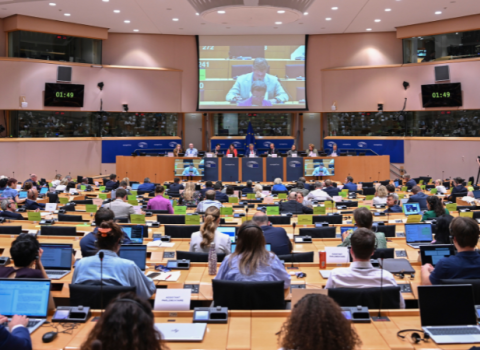FP10 must have a €200 billion budget if it is to realise the EU‘s research and innovation ambitions. And we already know how to get there

Daniel Spichtinger, consultant on EU research policy and projects. Photo credits: Daniel Spichtinger
With Europe significantly lagging behind other global regions in research and innovation investment, stakeholders have called for more financial firepower in FP10, the next EU research Framework Programme. A figure of €200-220 billion has circulated widely, an increase of 110-113% compared to the €95 billion allocated to Horizon Europe.
Is the notion of such a large increase unrealistic, as research commissioner Ekaterina Zaharieva recently suggested? Not necessarily. But it does require political will and commitment. One thing is clear: a doubling of the funding for research and innovation solely through the next Multiannual Financial Framework (MFF) is not politically feasible.
However, there is a precedent for providing funding additional to the MFF: the Next Generation EU programme (NGEU). Established as a response to the COVID-19 pandemic, the NGEU allowed the European Commission to raise €750 billion directly from financial markets through bonds. Most of this money went directly to EU member states through the Recovery and Resilience Facility, but some was also used to top up EU programmes. This included €5 billion for Horizon Europe.
However, the NGEU was conceptualised as a one-off programme, whose resources run out in 2026. A successor programme, let’s call it NGEU+, is the only feasible option to reach the €200 billion target for FP10.
Building a budget
How would this work in practice? The first step would be to secure a modest increase in FP 10 funding through the MFF for 2028-34.
The main source of money for the MFF is the EU’s ‘own resources’ and other revenue streams. These own resources are mainly drawn from member state contributions, plus some VAT and EU customs duties. In recent years, the Commission has proposed additions, such the plastic levy that bills member states for the quantity of non-recycled plastic packaging waste they generate.
In addition to these own resources, the EU generates revenue through other streams, albeit on a smaller scale. These include surpluses from previous budget cycles, fines imposed on companies for competition law violations and taxes collected from EU staff salaries. Using all these sources, the current MFF amounts to slightly more than €1 trillion in 2018 prices.
Horizon Europe draws €90 billion from the MFF. As part of the path to €200 billion, this MFF contribution to FP10 would be modestly increased to €100-105 billion.
This barely covers inflation, however, and is by no means sufficient to realise the EU’s ambitions to boost science and research. It is therefore imperative that the MFF funding is boosted by a successor to the NGEU.
Like its predecessor, NGEU+ would enable the Commission to raise money directly from the financial markets. And in the same vein, the repayment structure would be spread over decades to ensure that the NGEU+ provides a substantial increase in research funding without undue financial pressure.
As in the original NGEU, funds for the repayments would not come directly from EU member states but from new EU own resources. This could mean the aforementioned plastics levy, revenues from emissions trading, a carbon boarder adjustment mechanism, or profits from an agreement on international corporate taxation.
This NGEU successor programme would be designed to deliver another €100-105 billion, bringing FP10 to the target figure of €200-220 billion.
Is there a third way?
Alternatives to the NGEU+ approach are very unlikely to bear fruit. Increasing member state budget contributions is not politically viable and would certainly not be supported by governments already making a net contribution. Other revenue streams contributing to the EU's own resources might be increased, or new sources found, but this approach has only limited revenue-raising potential. On their own, they will not generate the €100 billion needed.
The idea of redistributing resources is also a dead end, with agricultural and regional funding both heavily protected by interest groups and unlikely to provide the resources needed.
Finally, there is the option of re-nationalising research funding by increasing member state co-funding through the partnership instrument. However, this would further aggravate the research and innovation gap between wealthier and poorer EU states, since only the rich states will be able to afford to co-fund a wide range of partnerships.
Call to action
From a technical perspective, an NGEU+ programme is the most viable and realistic option to arrive at the target figure of €200 billion for FP10.
But the idea will face political opposition, for example from neoliberal factions such as Germany’s Free Democratic Party, who view EU-level bonds as creating an undesirable debt union. Then there will be anti-EU voices who benefit politically from weakening the Union’s financial capabilities.
Given that decisions about the shape of the EU budget ultimately rest with national leaders and finance ministers, these are the people that need to be convinced and to be lobbied. They framed the original Next Generation EU as a one-off measure and any effort to create an NGEU+ for research will require leaders to justify going back on that original commitment.
However, the conversation around Europe’s security and defence capabilities has intensified, and discussions on establishing a European Defence Union are gaining political momentum. A second NGEU package, rather than being framed solely as a research funding mechanism, should be positioned as a broader investment tool for Europe’s security and strategic autonomy, with research as an important component.
Hence, the key technologies in which Europe needs to gain or maintain momentum for long-term competitiveness and resilience, such as AI, semiconductors, cybersecurity and quantum computing, could be funded through NGEU+. FP10’s more fundamental research instruments, such as the European Research Council and Marie Skłodowska-Curie Actions, could be funded within the traditional MFF structure.
There is also a precedent for how this could unfold politically: while the original NGEU was initially met with resistance, it ultimately proved successful, showing that EU-level borrowing can be an effective and sustainable mechanism to finance strategic investments.
In all of this, it is critical that the research stakeholder community lets its voice be heard. It should advocate vigorously for the strategic importance of FP10 and emphasise the return on investment that R&D brings to national economies. And it should lobby national governments on the merits of an NGEU+ mechanism.
One thing is clear: boosting investment in R&D is not just an expense, it’s Europe’s ticket to innovation, resilience and global leadership. And the only way to do that is through a Next Generation EU+ programme.
Daniel Spichtinger is a consultant on EU research policy and projects. He explains his idea further here.





 A unique international forum for public research organisations and companies to connect their external engagement with strategic interests around their R&D system.
A unique international forum for public research organisations and companies to connect their external engagement with strategic interests around their R&D system.